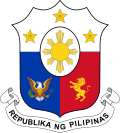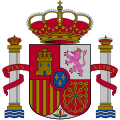 | |
Philippines |
Spain |
|---|---|
| Diplomatic mission | |
| Philippine Embassy, Madrid | Spanish Embassy, Manila |
| Envoy | |
| Ambassador Philippe Lhuillier | Ambassador Miguel Utray Delgado |
Philippines–Spain relations (Filipino: Ugnayang Pilipinas at Espanya; Spanish: Relaciones Filipinas y España) are the relations between the Philippines and Spain. The relations between the two nations span from the 16th century, the Philippines was the lone colony of the Spanish Empire in Asia for more than three centuries. Both nations are members of the Association of Academies of the Spanish Language and the United Nations.
History
Precedents
Even before the formal Spanish conquest of the Philippines, on the islands there were already Muslims and Moors who had escaped from the recently overthrown Emirate of Granada. As Muslim Castilian speakers were recorded to have been in the area as they spread throughout the Muslim world even as far as Islamic Manila, one of them was a man named Pazeculan This Castilian speaking Moor was in the service of the Rajah of Manila and Admiral of the Brunei Sultanate, Rajah Matanda, when he encountered the Magellan expedition.
Spanish conquest
See also: History of the Philippines (1565–1898) and Spanish East Indies
Spain and the Philippines share a common history in the fact that the Philippines was part of the Spanish Empire for three hundred years and was the sole Spanish colony in Asia. Portuguese explorer Ferdinand Magellan first encountered the Philippines and named the islands after King Philip II of Spain.
In 1565, Spanish explorer Miguel López de Legazpi arrived from present-day Mexico and established a European settlement in Cebu. Soon afterwards, the Captaincy General of the Philippines was governed from the Viceroyalty of New Spain, based in Mexico City. For the next 300 years, the Philippines was a Spanish province. Trade and communication between Spain and the Philippines was administered by the Manila galleon.
In 1896, the Philippine Revolution began for independence from Spain. The revolution lasted through 1898 when the Spanish–American War broke out. The Spanish–American War resulted in Spain losing its domain over the Philippines and the nation was transferred over to the United States, thus ending the Philippine Revolution. The Philippines would be governed by the United States until 1946.
Post Independence
During the Spanish Civil War, Filipino volunteers fought for both sides in the war. In 1947, the Philippines and Spain established diplomatic relations. It was manifested when Envoy Extraordinary and Minister Plenipotentiary Teodomiro de Aguilar presented his credentials to then-President Manuel Roxas on January 30, 1947. Aguilar mentioned to Roxas that his government had decided to establish a legation in the country as a living proof of the interest of Spain in this new republic.
On June 15, 1954, President Ramon Magsaysay's speech upon his acceptance of the credentials of Spanish Ambassador Extraordinary and Plenipotentiary Fermin Sanz Orio, was often heralded as the first time that a president used the national language to respond to a foreign envoy's credential speech.
On July 1, 1962, President Diosdado Macapagal and his entourage was welcomed by Generalissimo and Mrs. Francisco Franco upon their arrival at Barajas International Airport in Madrid.

Since the establishment of diplomatic relations, relations between both nations have strengthened through cultural and historical similarities. In 1995, King Juan Carlos I paid his first official visit to the Philippines. There have been several high-level visits between leaders of both nations.


King Juan Carlos I and his wife, Queen Sofia, attended the 1998 centennial celebrations in Manila, commemorating 100 years of independence from Spain. The mediation of the Spanish King is said to have produced the pardon and liberation of two Philippine domestic workers sentenced to death in Kuwait and the United Arab Emirates. Philippine President, Gloria Macapagal Arroyo, concluded her second state visit in Spain in July 2006, bringing back millions of dollars of Spanish investments, particularly in tourism and information technology.
Spanish Ambassador to the Philippines, Jorge Domecq, told the reporters that the "Philippines is the only country in Asia to receive more aid and development assistance from Spain than any other Asian country". He added that the Philippines remains a priority of the Spanish aid in development efforts and partnerships with the EU, even despite budget cuts on development funding brought on by austerity measures being implemented by the Government of Spain.
In July 2012, the Queen Sofia visited the Philippines for a fourth time. She inspected several development projects around the former Spanish colony that her country's government is funding via the AECID. She visited the National Library, National Museum and the University of Santo Tomas. She also met with Spanish nationals residing in the Philippines, and attend a reception at the Spanish Embassy. She also attended a state dinner in her honour at Malacañang Palace hosted by President Benigno Aquino III. Also during her visit in the former colony of her country, Queen Sofia expressed appreciation to Aquino for the country's effort to reintroduce the Spanish language in the Philippine public education system.
Filipinos are one of the largest Asian communities in Spain, with a number of individuals obtaining Spanish citizenship. Most Filipinos in Spain work in various jobs and companies such as domestic and healthcare services, some individuals also work in education and government institutions.
In 2017, both nations celebrated 70 year of diplomatic relations. However, in 2019, the Philippine president, Rodrigo Duterte, dictated that he wanted to change the name of the country "Philippines" to "erase the Spanish historical trail", something he failed to do. On September 5 of the same year, the Spanish frigate Méndez Núñez made the historic port-visit, making it the first Spanish Navy vessel in the Philippines, since the Battle of Manila Bay during the Spanish–American War in 1898.
Currently, diplomatic relations between Spain and the Philippines are considerably weaker unlike the priorities that Spain has with other ASEAN countries, such as Cambodia, Indonesia, Singapore, Thailand, and Vietnam. However, their relations have continued to be maintained, based on a shared history and culture. Likewise, in 2022, both countries celebrated the 75th anniversary of the establishment of diplomatic relations.
Cultural cooperation
Both countries have tried to rescue their historical ties. Since 2002, the Philippine–Spanish Friendship Day is celebrated every June 30, promoted with the aim of strengthening the relationship between both nations that share history, values, and traditions.
In 2009, the Philippine academic and former president, Gloria Macapagal Arroyo, was awarded the Don Quixote International Prize, which recognized the Philippine educational initiative to introduce the Spanish language in the Philippines. In this sense, on February 23, 2010, during the V Spain-Philippines Tribune, an agreement was reached between the Ministries of Education of Spain and the Philippines, the Instituto Cervantes, and the AECID, by which all secondary school students in the Philippines have the option to study Spanish since 2012.
Bilateral agreements
Both nations have signed several bilateral agreements such as a Treaty on civil rights and consular powers (1948); Treaty on the validity of academic degrees and the exercise of professions (1949); Air transportation agreement (1951); Agreement on the suppression of visas for diplomatic and official passport holders (1962); Agreement on technical cooperation in tourism (1971); Agreement on social security (1988); Agreement on economic and industrial cooperation (1988); Agreement to avoid double taxation and prevent tax evasion of income taxes (1989); Agreement for the promotion and reciprocal protection of investments (1992); Extradition treaty (2004); Memorandum of Understanding on Technical Cooperation in Matters of tourism (2007); Memorandum of Understanding of Cooperation in the field of Renewable Energies and Biofuels (2007); Agreement on Cultural, Sports and Educational Cooperation (2007); Treaty on transfer of convicted persons (2007) and an Agreement on cooperation in the fight against transnational crime (2015).
See also: Foreign relations of the Philippines, Foreign relations of Spain, and List of ambassadors of the Philippines to SpainResident diplomatic missions
- Philippines has an embassy in Madrid and a consulate-general in Barcelona.
- Spain has an embassy in Manila.
-
 Embassy of the Philippines in Madrid
Embassy of the Philippines in Madrid
-
 Consulate-General of the Philippines in Barcelona
Consulate-General of the Philippines in Barcelona
-
 Torre BDO hosting the Embassy of Spain in Manila
Torre BDO hosting the Embassy of Spain in Manila
Country comparison
See also
References
- Damiao de Gois, Cronica do felicissimo rei de. Manuel (Lisboa, 1566), part 2, p. 113.
- 'El libro que trajo la nao Vitoria de las amistades que hitieron con 10s Reyes de Maluco" (Archivo General de Indias, Indiferente General 1528), text in Mauricio Obregon, La primera vuelta al Mundo (Bogota, 1984), p. 300.
- History of the Philippines
- ^ "70 Aniversario de Relaciones Diplomáticas (in Spanish)". Archived from the original on 2018-01-21. Retrieved 2019-09-25.
- Castro, Pacifico (1985). Diplomatic Agenda of Philippine Presidents: 1946-1985. Foreign Service Institute. p. 4.
- Castro 1985, p. 41.
- Castro 1985, p. 111.
- ^ Relaciones entre España y la Filipinas (in Spanish)
- "Philippines is only country in Asia to receive aid from Spain". InterAksyon. January 21, 2013. Archived from the original on October 26, 2016. Retrieved January 21, 2013.
- Archived August 13, 2012, at the Wayback Machine
- "Albay gives Spanish queen warm welcome". Inquirer Global Nation. 5 July 2012.
- "PNoy and Spain's Queen Sofia welcome return of Spanish language in PHL schools". GMA News. July 3, 2012.
- "Filipino Among Royal Guards of King of Spain". ABS CBN News. Retrieved July 2, 2009.
- "El presidente de Filipinas quiere cambiar el nombre del país por ser una herencia "brutal" de los españoles". La Razón (in Spanish). 4 March 2019.
- "Spanish Navy ship in PH for goodwill visit". Philippine News Agency. 5 September 2019. Retrieved 5 September 2019.
- Ramón Pacheco Pardo, "Spain and Asia: harnessing trade, soft power and the EU in the Asia-Pacific Century." (ARI #61, 2017) online.
- "Filipinas" (PDF). Oficina de Información Diplomática (in Spanish).
- "Embassy Commemorates 75th Anniversary of Philippines-Spain Diplomatic Relations". Embassy of the Philippines in Madrid, Spain. 22 November 2022.
- "España y Filipinas, siete décadas de amistad en imágenes". La Vanguardia (in Spanish). 6 October 2017.
- "Día de la Amistad Hispano-Filipina". Asociación Cultural Galeón de Manila (in Spanish).
- "La "paelya" y todo lo que no sabías sobre la conexión entre España y Filipinas". 20 minutos (in Spanish). 10 March 2023.
- "Gloria Macapagal y Mario Vargas Llosa, premiados con los Don Quijote 2009". Informativos Telecinco (in Spanish). 2009. Archived from the original on September 20, 2011.
- "Todos los alumnos de Secundaria de Filipinas tendrán la opción de estudiar español". Europa Press (in Spanish). 2010.
- Embassy of the Philippines in Madrid
- Embassy of Spain in Manila
- Literally President of the Government but formally known by English-speaking nations and formally translated by the European Commission Directorate-General in English as Prime Minister
External links
 Media related to Relations of the Philippines and Spain at Wikimedia Commons
Media related to Relations of the Philippines and Spain at Wikimedia Commons
| Africa |  | |
|---|---|---|
| Americas | ||
| Asia | ||
| Europe | ||
| Oceania | ||
| Former states | ||
| Multilateral relations | ||
| Diplomacy | ||




